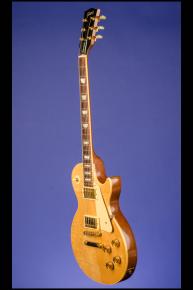"This is where the proper, modern Re-Issue starts"
A very unusual example with a natural maple top and all gold hardware…
1991 Gibson Les Paul Standard (1960 re-issue).
This very beautiful and unusual early 1960 Les Paul Standard re-issue weighs just 9.00 lbs. Solid mahogany body with a 'natural' book-matched carved maple top. One-piece mahogany neck, with a perfect nut width of just over 1 11/16 inches and a really comfortable thin-to-medium 1960 neck profile which measures just 0.80 inches at the first fret and rises gently to 0.88 inches at the 12th fret. Rosewood fretboard with 22 original medium jumbo frets and inlaid pearl trapezoid position markers. Headstock with inlaid pearl "Gibson" logo and "Les Paul Model" silkscreened in gold. Two layer black on white, bell-shaped plastic truss rod cover engraved in white "Standard" and secured by two screws. The back of the headstock with the serial number "93221422" and "Made in USA" stamped in blind. Individual Gibson (Kluson) Deluxe double-line tuners with single-ring tulip-shaped Keystone plastic buttons. One Gibson Burstbucker Type 2 pickup in the neck position with an output of 8.11k, and one Gibson Burstbucker Type 3 pickup in the bridge position with a really hot output of 12.66k. Both pickups are engraved on the underside "PAT. NO. 2,737,842". Four controls (two volume, two tone) on lower treble bout plus a three-way selector switch on upper bass bout. The potentiometers are stamped "137 91 43" (CTS October 1991). Gold "Speed" knobs with white numbers. Gibson [ABR-1] Tune-O-Matic retainer bridge with metal saddles and separate stud tailpiece. All hardware gold-plated. Inside the neck pickup cavity is written "Nat" and inside the bridge pickup cavity is written "G G". This extremely rare example, with a figured natural maple top, is in exceptionally fine (9.00) condition with just a few small surface marks/indentations and two small scratches on the back of the neck, one on the treble-side behind the third fret and the other on the bass side behind the sixth fret. Housed in its original Gibson brown hardshell case with purple plush lining and silk cover (9.25).
"On the shop floor of the original Gibson plant in Kalamazoo, Michigan, the earliest Gibson “Patent Applied For” humbuckers were wound using imprecise machines, resulting in pickups with varying degrees of output and tone. The BurstBucker™ line of pickups represents Gibson’s drive to recapture the magic of the original “Patent Applied For” humbuckers. First introduced in the early 1990s, the Gibson BurstBucker™ — Types 1, 2, and 3 — successfully captured the subtle variations of true, classic humbucker tone with historically “unmatched” bobbin windings and Alnico II magnets. They produce an airy, full tone, and when overdriven they achieve a magical distortion with the slightly enhanced highs that made the originals famous. BurstBucker™ Type 1 features a lower output, excellent for the neck position. BurstBucker™ Type 2 features medium output, and is perfect for both positions. BurstBucker™ Type 3 is overwound and hot, which is typically ideal for the bridge position. None of the BurstBuckers™ are wax potted, and all feature vintage braided two-conductor wiring. Slightly overwound, with hotter output, the BurstBucker Type 3 works well in the bridge position with a BurstBucker Type 2 in the neck position.' (Musicians Friend).
"J.T. Riboloff in the Custom Shop had found that a lot of players who asked him to build special one-off Les Pauls were requesting the slimmer-profile neck associated with the 1960 Standard. Gibson boss Henry Juszkiewicz noted the flurry of interest when the company showed an example at a NAMM trade-show and told Riboloff to start work on a production version. This appeared in 1990, called the Les Paul Classic. "One of my main things," said Riboloff, "was to try to get the stock instrument to be just as cool as the custom ones. That's really how the Les Paul Classic came about"… A year later, in 1991, the Standard Reissue was revised and split into two models, effectively the 59 and the 60. This is where the proper, modern Reissue starts. These models adopted the 'correct' details of the Classic, as well as more traditional-sounding humbuckers, as developed by Riboloff" (Tony Bacon, 50 Years of the Gibson Les Paul, p. 105).












